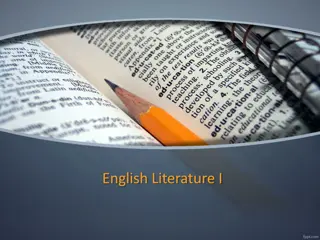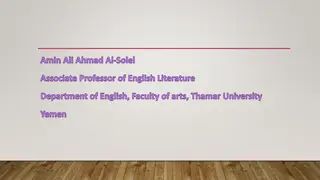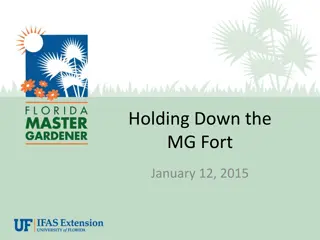Exploring English Education at NATE Conference 2015
Delve into the thought-provoking presentation by Geoff Barton at the NATE Conference 2015, where questions about English education are raised. From nurturing learners to developing teachers, this session challenges the traditional views on teaching and learning English. Dive into the essence of creating a brave new world in education.
Download Presentation

Please find below an Image/Link to download the presentation.
The content on the website is provided AS IS for your information and personal use only. It may not be sold, licensed, or shared on other websites without obtaining consent from the author. Download presentation by click this link. If you encounter any issues during the download, it is possible that the publisher has removed the file from their server.
E N D
Presentation Transcript
O Brave New World: NATE Conference 2015 Geoff Barton Head, King Edward VI School, Suffolk Download this presentation at www.geoffbarton.co.uk (138) Twitter: @RealGeoffBarton
Miranda: O, wonder! How many goodly creatures are there here!How beauteous mankind is! O brave new world, That has such people in't! Prospero: Tisnew to thee
Provocations Questions Principles
1: What is English for at your school?
2: What kind of learners are we creating?
3: What kind of readers?
4: What kind of writers?
5: What kind of teachers are we developing?
The view from here Master: We run ourselves aground
Those who stand for nothing fall for anything Alexander Hamilton Founding Father, 1755-1803
The Preachers of Culture
You taught me language, and my profit on t Is I know how to curse.
No one can make you feel inferior without your consent Eleanor Roosevelt
1: What is English for at your school?
2: What kind of learners are we creating?
3: What kind of readers?
4: What kind of writers?
5: What kind of teachers are we developing?
1: What is English at your school for? What does English distinctively add to the culture of your school? What are the non-negotiable activities and texts of your curriculum? Does it combine depth with breadth? Does it relate to your distinctive context? Does it challenge students linguistically and conceptually more than they might expect? Does it raise aspirationsfor the word poor ?
2: What kind of learners are we creating? Does English pass the Google test? The past illuminating the present? Soft skills: teamwork, problem-solving, resilience, debating, journalism? Equip them with the language of power? Relish for & curiosity about the endless playfulness of language Assisting the word poor alongside the word rich ?
The past illuminating the present
3: What kind of readers? At the heart of English: a reading curriculum Inquisitive readers taught by inquisitive readers, high culture rubbing shoulders with low Understand how reading works: skimming, scanning, analysis, lexical v grammatical words, conventions of texts, point-of-view, unreliable narrators, endings, speech verbs, drop paragraphs Built on prior knowledge Research, not FOFO.
What if JD Salinger rewrote The Book of Genesis ?
Boy, when I saw old Eve I thought I was going to flip. I mean it isnt that Eve is good-looking or anything like that, it s just that she s different. I don t know what the hell it is exactly but you always know when she s around. She looked nervous as hell. I kinda felt sorry for her even though she s got one of my goddam ribs, so I went over to talk to old Eve. You look very, verynice, Adam she said to me in a funny way, like she was ashamed of something. Why don t you join me in some apple? Goddam, is that all these sophisticated babes think about all the time? It s enough to drive a guy crazy, if you know what I mean. From Simon Brett, The Faber Book of Parodies
What if Dylan Thomas rewrote Pride & Prejudice ?
Adventures In The Marriage Trade FIRST VOICE: It is night in the smug-as-a-bug-in-a-rug household of Mr and Mrs Dai Bennet and their simpering daughters five breast-bobbing man-hungry titivators, innocent as ice-cream, panting for balls and matrimony. MRS BENNET: Our new neighbour, Mr Darcy, quite tickles my fancy. MR BENNET: Don t let him turn Lizzy s head, Darcy-versy. ELIZABETH: I shall wed whom I please. FIRST VOICE: And busy Lizzie retires to her room with visions of bridling up the aisle to I will with half-a-dozen demon lovers. She dreams of coaches and pairs and being a fine lady; dressing for dinner in silken gown and undressing afterwards for heaven knows what in the saucy haven of a double bed. From EO Parrott, How to be Well Versed in Poetry
You will need: a basic patch repair kit, including: tyre levers fine sandpaper or emery board rubber solution patch bike pump 1. Take the wheel off the bike, and using the tyre levers take the tyre off one side of the rim so you can pull the inner tube out. You might be able to save time by leaving the valve of the tube in the wheel as shown below, but only if the hole is elsewhere on the tube. Blow the tube up. You can find a puncture by listening for the hiss of escaping air. The smallest, slowest punctures are hardest to find you may have to immerse the tube in water and look for bubbles. In an emergency, a puddle will do. 2. Once you find a puncture it will lead you to the right section of tyre to look for a hole or a sharp object. Check the tyre for grit, glass, thorns or nails. Check for holes where they may have been. The flint, thorn or glass that caused the puncture may have been blown out by the escaping air, or dislodged in the last few metres when you were running on a flat tyre. Pick out whatever caused the puncture. Tweezers or a pin may be useful.
You will need: a basic patch repair kit, including: tyre levers fine sandpaper or emery board rubber solution patch bike pump 1. Take the wheel off the bike, and using the tyre levers take the tyre off one side of the rim so you can pull the inner tube out. You might be able to save time by leaving the valve of the tube in the wheel as shown below, but only if the hole is elsewhere on the tube. Blow the tube up. You can find a puncture by listening for the hiss of escaping air. The smallest, slowest punctures are hardest to find you may have to immerse the tube in water and look for bubbles. In an emergency, a puddle will do. 2. Once you find a puncture it will lead you to the right section of tyre to look for a hole or a sharp object. Check the tyre for grit, glass, thorns or nails. Check for holes where they may have been. The flint, thorn or glass that caused the puncture may have been blown out by the escaping air, or dislodged in the last few metres when you were running on a flat tyre. Pick out whatever caused the puncture. Tweezers or a pin may be useful.
You will need: a basic patch repair kit, including: tyre levers fine sandpaper or emery board rubber solution patch bike pump 1. Take the wheel off the bike, and using the tyre levers take the tyre off one side of the rim so you can pull the inner tube out. You might be able to save time by leaving the valve of the tube in the wheel as shown below, but only if the hole is elsewhere on the tube. Blow the tube up. You can find a puncture by listening for the hiss of escaping air. The smallest, slowest punctures are hardest to find you may have to immerse the tube in water and look for bubbles. In an emergency, a puddle will do. 2. Once you find a puncture it will lead you to the right section of tyre to look for a hole or a sharp object. Check the tyre for grit, glass, thorns or nails. Check for holes where they may have been. The flint, thorn or glass that caused the puncture may have been blown out by the escaping air, or dislodged in the last few metres when you were running on a flat tyre. Pick out whatever caused the puncture. Tweezers or a pin may be useful.
You will need: a basic patch repair kit, including: tyre levers fine sandpaper or emery board rubber solution patch bike pump 1. Take the wheel off the bike, and using the tyre levers take the tyre off one side of the rim so you can pull the inner tube out. You might be able to save time by leaving the valve of the tube in the wheel as shown below, but only if the hole is elsewhere on the tube. Blow the tube up. You can find a puncture by listening for the hiss of escaping air. The smallest, slowest punctures are hardest to find you may have to immerse the tube in water and look for bubbles. In an emergency, a puddle will do. 2. Once you find a puncture it will lead you to the right section of tyre to look for a hole or a sharp object. Check the tyre for grit, glass, thorns or nails. Check for holes where they may have been. The flint, thorn or glass that caused the puncture may have been blown out by the escaping air, or dislodged in the last few metres when you were running on a flat tyre. Pick out whatever caused the puncture. Tweezers or a pin may be useful.
You will need: a basic patch repair kit, including: tyre levers fine sandpaper or emery board rubber solution patch bike pump 1. Take the wheel off the bike, and using the tyre levers take the tyre off one side of the rim so you can pull the inner tube out. You might be able to save time by leaving the valve of the tube in the wheel as shown below, but only if the hole is elsewhere on the tube. Blow the tube up. You can find a puncture by listening for the hiss of escaping air. The smallest, slowest punctures are hardest to find you may have to immerse the tube in water and look for bubbles. In an emergency, a puddle will do. 2. Once you find a puncture it will lead you to the right section of tyre to look for a hole or a sharp object. Check the tyre for grit, glass, thorns or nails. Check for holes where they may have been. The flint, thorn or glass that caused the puncture may have been blown out by the escaping air, or dislodged in the last few metres when you were running on a flat tyre. Pick out whatever caused the puncture. Tweezers or a pin may be useful.
You will need: a basic patch repair kit, including: tyre levers fine sandpaper or emery board rubber solution patch bike pump 1. Take the wheel off the bike, and using the tyre levers take the tyre off one side of the rim so you can pull the inner tube out. You might be able to save time by leaving the valve of the tube in the wheel as shown below, but only if the hole is elsewhere on the tube. Blow the tube up. You can find a puncture by listening for the hiss of escaping air. The smallest, slowest punctures are hardest to find you may have to immerse the tube in water and look for bubbles. In an emergency, a puddle will do. 2. Once you find a puncture it will lead you to the right section of tyre to look for a hole or a sharp object. Check the tyre for grit, glass, thorns or nails. Check for holes where they may have been. The flint, thorn or glass that caused the puncture may have been blown out by the escaping air, or dislodged in the last few metres when you were running on a flat tyre. Pick out whatever caused the puncture. Tweezers or a pin may be useful.
You will need: a basic patch repair kit, including: tyre levers fine sandpaper or emery board rubber solution patch bike pump 1. Take the wheel off the bike, and using the tyre levers take the tyre off one side of the rim so you can pull the inner tube out. You might be able to save time by leaving the valve of the tube in the wheel as shown below, but only if the hole is elsewhere on the tube. Blow the tube up. You can find a puncture by listening for the hiss of escaping air. The smallest, slowest punctures are hardest to find you may have to immerse the tube in water and look for bubbles. In an emergency, a puddle will do. 2. Once you find a puncture it will lead you to the right section of tyre to look for a hole or a sharp object. Check the tyre for grit, glass, thorns or nails. Check for holes where they may have been. The flint, thorn or glass that caused the puncture may have been blown out by the escaping air, or dislodged in the last few metres when you were running on a flat tyre. Pick out whatever caused the puncture. Tweezers or a pin may be useful.
You will need: a basic patch repair kit, including: tyre levers fine sandpaper or emery board rubber solution patch bike pump 1. Take the wheel off the bike, and using the tyre levers take the tyre off one side of the rim so you can pull the inner tube out. You might be able to save time by leaving the valve of the tube in the wheel as shown below, but only if the hole is elsewhere on the tube. Blow the tube up. You can find a puncture by listening for the hiss of escaping air. The smallest, slowest punctures are hardest to find you may have to immerse the tube in water and look for bubbles. In an emergency, a puddle will do. 2. Once you find a puncture it will lead you to the right section of tyre to look for a hole or a sharp object. Check the tyre for grit, glass, thorns or nails. Check for holes where they may have been. The flint, thorn or glass that caused the puncture may have been blown out by the escaping air, or dislodged in the last few metres when you were running on a flat tyre. Pick out whatever caused the puncture. Tweezers or a pin may be useful.
You will need: a basic patch repair kit, including: tyre levers fine sandpaper or emery board rubber solution patch bike pump 1. Take the wheel off the bike, and using the tyre levers take the tyre off one side of the rim so you can pull the inner tube out. You might be able to save time by leaving the valve of the tube in the wheel as shown below, but only if the hole is elsewhere on the tube. Blow the tube up. You can find a puncture by listening for the hiss of escaping air. The smallest, slowest punctures are hardest to find you may have to immerse the tube in water and look for bubbles. In an emergency, a puddle will do. 2. Once you find a puncture it will lead you to the right section of tyre to look for a hole or a sharp object. Check the tyre for grit, glass, thorns or nails. Check for holes where they may have been. The flint, thorn or glass that caused the puncture may have been blown out by the escaping air, or dislodged in the last few metres when you were running on a flat tyre. Pick out whatever caused the puncture. Tweezers or a pin may be useful.
You will need: a basic patch repair kit, including: tyre levers fine sandpaper or emery board rubber solution patch bike pump 1. Take the wheel off the bike, and using the tyre levers take the tyre off one side of the rim so you can pull the inner tube out. You might be able to save time by leaving the valve of the tube in the wheel as shown below, but only if the hole is elsewhere on the tube. Blow the tube up. You can find a puncture by listening for the hiss of escaping air. The smallest, slowest punctures are hardest to find you may have to immerse the tube in water and look for bubbles. In an emergency, a puddle will do. 2. Once you find a puncture it will lead you to the right section of tyre to look for a hole or a sharp object. Check the tyre for grit, glass, thorns or nails. Check for holes where they may have been. The flint, thorn or glass that caused the puncture may have been blown out by the escaping air, or dislodged in the last few metres when you were running on a flat tyre. Pick out whatever caused the puncture. Tweezers or a pin may be useful.
Walnuts are rounded, single-seeded stone fruits of the walnut tree commonly used for the meat after fully ripening. Following full ripening, the removal of the husk reveals the wrinkly walnut shell, which is usually commercially found in two segments (three- segment shells can also form). During the ripening process, the husk will become brittle and the shell hard. The shell encloses the kernel or meat, which is usually made up of two halves separated by a partition. The seed kernels commonly available as shelled walnuts are enclosed in a brown seed coat which contains antioxidants. The antioxidants protect the oil-rich seed from atmospheric oxygen, thereby preventing rancidity. Walnuts are late to grow leaves, typically not until more than halfway through the spring. They secrete chemicals into the soil to prevent competing vegetation from growing. Because of this, flowers or vegetable gardens should not be planted close to them. The two most common major species of walnuts are grown for their seeds the Persian or English walnut and the black walnut. The English walnut (J. regia) originated in Persia, and the black walnut (J. nigra) is native to eastern North America. The black walnut is of high flavor, but due to its hard shell and poor hulling characteristics it is not grown commercially for nut production. Numerous walnut cultivars have been developed commercially, which are nearly all hybrids of the English walnut.
Walnuts are rounded, single-seeded stone fruits of the walnut tree commonly used for the meat after fully ripening. Following full ripening, the removal of the husk reveals the wrinkly walnut shell, which is usually commercially found in two segments (three- segment shells can also form). During the ripening process, the husk will become brittle and the shell hard. The shell encloses the kernel or meat, which is usually made up of two halves separated by a partition. The seed kernels commonly available as shelled walnuts are enclosed in a brown seed coat which contains antioxidants. The antioxidants protect the oil-rich seed from atmospheric oxygen, thereby preventing rancidity. Walnuts are late to grow leaves, typically not until more than halfway through the spring. They secrete chemicals into the soil to prevent competing vegetation from growing. Because of this, flowers or vegetable gardens should not be planted close to them. The two most common major species of walnuts are grown for their seeds the Persian or English walnut and the black walnut. The English walnut (J. regia) originated in Persia, and the black walnut (J. nigra) is native to eastern North America. The black walnut is of high flavor, but due to its hard shell and poor hulling characteristics it is not grown commercially for nut production. Numerous walnut cultivars have been developed commercially, which are nearly all hybrids of the English walnut.
Walnuts are rounded, single-seeded stone fruits of the walnut tree commonly used for the meat after fully ripening. Following full ripening, the removal of the husk reveals the wrinkly walnut shell, which is usually commercially found in two segments (three- segment shells can also form). During the ripening process, the husk will become brittle and the shell hard. The shell encloses the kernel or meat, which is usually made up of two halves separated by a partition. The seed kernels commonly available as shelled walnuts are enclosed in a brown seed coat which contains antioxidants. The antioxidants protect the oil-rich seed from atmospheric oxygen, thereby preventing rancidity. Walnuts are late to grow leaves, typically not until more than halfway through the spring. They secrete chemicals into the soil to prevent competing vegetation from growing. Because of this, flowers or vegetable gardens should not be planted close to them. The two most common major species of walnuts are grown for their seeds the Persian or English walnut and the black walnut. The English walnut (J. regia) originated in Persia, and the black walnut (J. nigra) is native to eastern North America. The black walnut is of high flavor, but due to its hard shell and poor hulling characteristics it is not grown commercially for nut production. Numerous walnut cultivars have been developed commercially, which are nearly all hybrids of the English walnut.
Walnuts are rounded, single-seeded stone fruits of the walnut tree commonly used for the meat after fully ripening. Following full ripening, the removal of the husk reveals the wrinkly walnut shell, which is usually commercially found in two segments (three- segment shells can also form). During the ripening process, the husk will become brittle and the shell hard. The shell encloses the kernel or meat, which is usually made up of two halves separated by a partition. The seed kernels commonly available as shelled walnuts are enclosed in a brown seed coat which contains antioxidants. The antioxidants protect the oil-rich seed from atmospheric oxygen, thereby preventing rancidity. Walnuts are late to grow leaves, typically not until more than halfway through the spring. They secrete chemicals into the soil to prevent competing vegetation from growing. Because of this, flowers or vegetable gardens should not be planted close to them. The two most common major species of walnuts are grown for their seeds the Persian or English walnut and the black walnut. The English walnut (J. regia) originated in Persia, and the black walnut (J. nigra) is native to eastern North America. The black walnut is of high flavor, but due to its hard shell and poor hulling characteristics it is not grown commercially for nut production. Numerous walnut cultivars have been developed commercially, which are nearly all hybrids of the English walnut.
Dementor Wasps and Worse 1 How long is the stick-insect? 2 How many species of insects have been found? 3 Who is the conservation director for WWF-Greater Mekong? 4 Which was the 10,000th creature to be discovered? 5 What are the main features of the long-toothed pipistrelle bat?
Dementor Wasps and Worse 1 How long is the stick-insect? 2 How many species of insects have been found? 3 Who is the conservation director for WWF-Greater Mekong? 4 Which was the 10,000th creature to be discovered? 5 What are the main features of the long-toothed pipistrelle bat?
A dementor wasp named after the Harry Potter creatures, a stick insect more than half a metre long, and a colour-changing thorny frog are among new species discovered in South East Asia s Greater Mekong region. The discoveries also include a bent-toed gecko which is the 10,000th reptile to be recorded on Earth, a feathered coral whose nearest relatives are found in Africa and four moths named after Thai princesses. A total of 139 new species were identified in the region in 2014, including a new mammal - a long-toothed pipistrelle bat - as well as 90 plants, 23 reptiles, 16 amphibians and nine fish found by scientists. It brings the total number of species found in the Greater Mekong, which covers Cambodia, Laos, Burma, and Vietnam, between 1997 and 2014 to 2,216 or an average of three new plants or creatures a week. But many of the newly-discovered species are already at risk from threats such as destruction of their habitat, poaching or the illegal wildlife trade, a Magical Mekong report by wildlife charity WWF warned. Teak Seng, conservation director for WWF-Greater Mekong, said: The Greater Mekong s unique ecosystems are truly the gift that keeps on giving, providing sanctuary for a treasure trove of species and critical benefits for millions of people across the region. As Magical Mekong reveals, the scientists behind these discoveries feel they are racing against the clock to document them and strongly advocate for their protection before they disappear. The Ampulex dementor wasp from Thailand, which was named by popular vote after the soul-sucking creatures in the Harry Potter books, paralyses its prey with venom before eating them alive. A stick insect measuring 54cm (21 inches), making it - for now - the world s second largest insect, was found in Vietnam, while a stealthy wolf snake with a flying bat pattern on its skin which helps it blend into trees and mosses was discovered in Cambodia.























